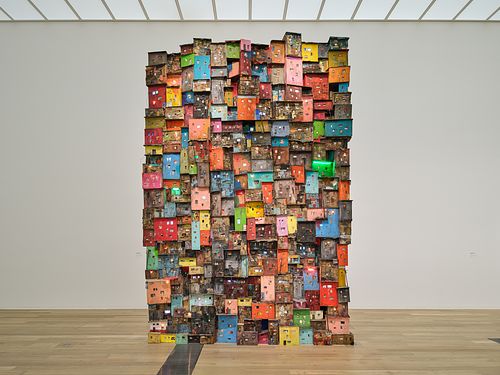AUDIO
Tracey Snelling
The American artist Tracey Snelling once told me that the idea for her work One Thousand Shacks came to her while meditating. She then quickly made a sketch which already showed everything we see in the installation today: the monumentality, the slightly askew huts piled atop each other, the many cables running in all directions.
One Thousand Shacks reminds us of slums all over the world. And it is true that Tracey Snelling is not referring to a certain country or a specific city. Her installations stand for the precarious living conditions of people living in poverty everywhere. In my view, the artist has achieved something incredible: she attracts attention to the problem without pointing fingers. It is easy to fall in love with the many details that Snelling uses to breathe life into the huts. The small rugs, the lanterns, the chairs and tables. It is a caring gaze, yet without seeming full of pity.
Tracey Snelling spent about nine months working on the installation. Its height of 5 meters (or around 6 feet) was important to her. On the one hand, the size overwhelms us, yet on the other, it symbolizes the dimensions of such under-served neighborhoods. The great variety of the colorful houses attests to the unplanned growth of such areas. Light and conversations in various languages emanate from the windows and doors. They fill the entire installation with pulsating and bustling life. The wall itself becomes a vibrant whole.
Most of the videos were originally material from television that Tracey Snelling collected, edited, and remixed. All of them show everyday life in the impoverished districts of various countries. Seen here are not only conflict situations but also the strong solidarity among residents.
The videos allow our gaze to drift beyond the living spaces of these people—to focus on their social environment as well. It is evident that the two are interrelated and mutually dependent. And with regard to the exhibition, I think it becomes clear that people living in such cramped living quarters experience not only their own space at close range, but that of their neighbors as well.
One Thousand Shacks reminds us of slums all over the world. And it is true that Tracey Snelling is not referring to a certain country or a specific city. Her installations stand for the precarious living conditions of people living in poverty everywhere. In my view, the artist has achieved something incredible: she attracts attention to the problem without pointing fingers. It is easy to fall in love with the many details that Snelling uses to breathe life into the huts. The small rugs, the lanterns, the chairs and tables. It is a caring gaze, yet without seeming full of pity.
Tracey Snelling spent about nine months working on the installation. Its height of 5 meters (or around 6 feet) was important to her. On the one hand, the size overwhelms us, yet on the other, it symbolizes the dimensions of such under-served neighborhoods. The great variety of the colorful houses attests to the unplanned growth of such areas. Light and conversations in various languages emanate from the windows and doors. They fill the entire installation with pulsating and bustling life. The wall itself becomes a vibrant whole.
Most of the videos were originally material from television that Tracey Snelling collected, edited, and remixed. All of them show everyday life in the impoverished districts of various countries. Seen here are not only conflict situations but also the strong solidarity among residents.
The videos allow our gaze to drift beyond the living spaces of these people—to focus on their social environment as well. It is evident that the two are interrelated and mutually dependent. And with regard to the exhibition, I think it becomes clear that people living in such cramped living quarters experience not only their own space at close range, but that of their neighbors as well.
